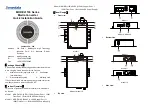
10,000 Watt AC Inverter by Wagan Tech
Connect the fuse holders to the short positive (+) cable terminals.
Wrap the inverter positive cable ends with insulating plastic wrap.
Mount the fuse holders to a support structure.
Install fuses in the fuse holders and tighten the retaining nuts.
Install the Ground wire from the inverter enclosure to the grounding point.
WARNING: THE PROCEDURE THAT FOLLOWS IS FOR SAFE CONNECTION TO MINIMIZE
INITIAL CONNECTION SPARKING AND DAMAGE FROM UNPROTECTED BATTERY CABLE
SHORTS.
Making the first connection between the positive cable and the inverter’s positive terminal
may cause a spark. This is a normal and is a result of capacitors in the inverter starting to
charge. Because of the possibility of sparking, it is extremely important that both the inverter
and the battery bank be positioned away from any source of flammable fumes or gases.
Failure to heed this warning can result in fire or explosion. Do not make the first positive
terminal connection immediately after batteries have been charging. Allow time for the
battery gasses to vent to outside air.
Inverter to Battery Connection Procedure
Disconnect any Remote Switch Connector from the front panel of the inverter.
Make sure the ON/OFF switch located on the front panel of the inverter is in the
OFF position.
Install all non-fused (negative) cables from the negative battery bank terminal to the
Negative (−) Terminals on the rear of the inverter.
Tighten the retaining nuts.
Connect all fuses end positive cable ring terminals to the positive battery bank
terminal.
Carefully tighten the retaining nuts. DO NOT SHORT BATTERY POSITIVE TO
NEGATIVE OR GROUND.
At the inverter end carefully unwrap one positive cable end and connect it to one
Positive Terminal. A spark is likely to result. This is normal.
Tighten the retaining nut. BE CAREFUL; DO NOT SHORT THE POSITIVE TERMINAL
TO THE GROUNDED INVERTER ENCLOSURE.
Continue installing the remaining positive cables.
Turn ON the inverter. The display on the front panel should show between 0.5 to
5 volts depending on the voltage of the power source. When the voltage reading
does not fall within this range, check the connections of the wires to the terminals
on the power source and the inverter to make sure they are secure. Also check the
voltage of the power source. Make certain that the High Temp or Overload LED
Indicators are not lit.
Turn OFF the inverter. The Overload and Over Temp LEDs may briefly “flash”. This
is normal. The audible alarm may also emit a short “chirp”. This is also normal.
4.
5.
6.
7.
8.
.
2.
3.
4.
5.
6.
7.
8.
9.
0.
.
R
www.wagan.com






































